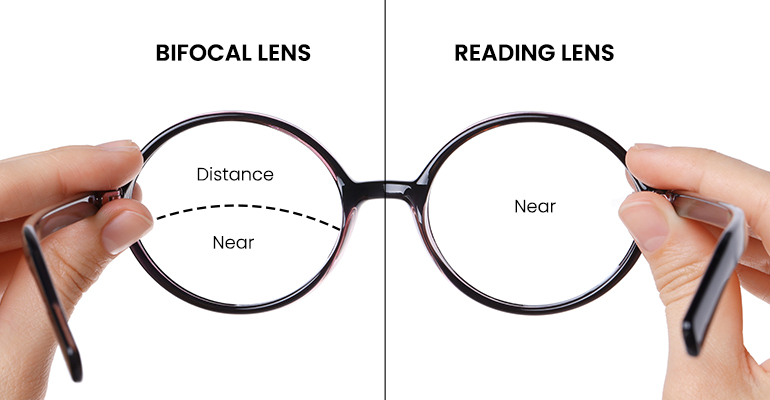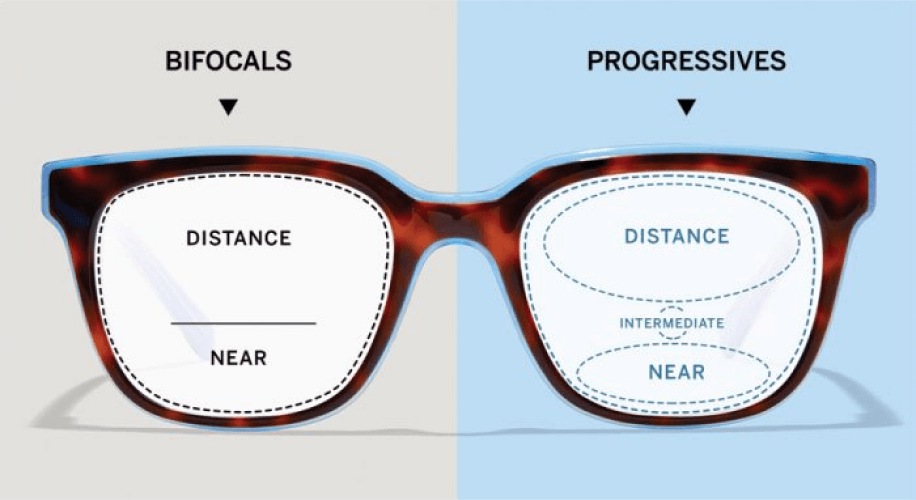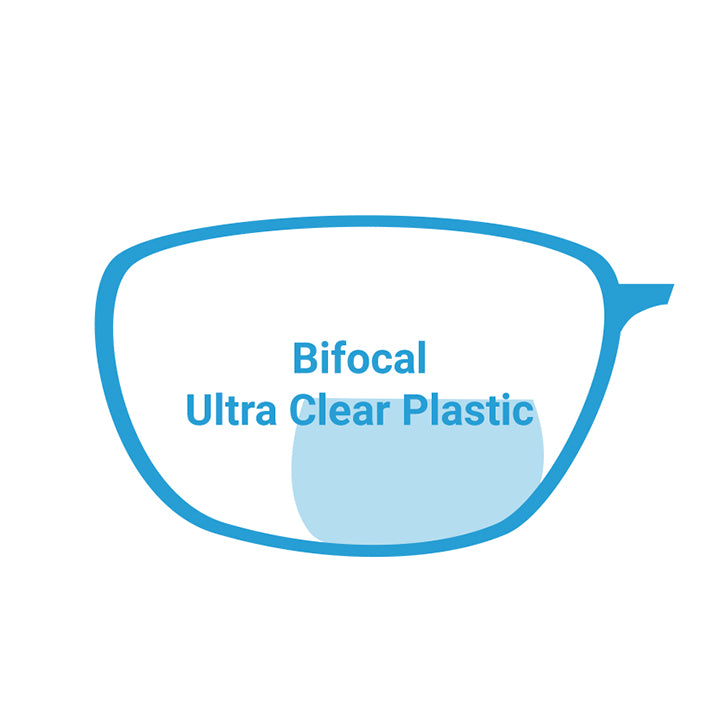The Ultimate Guide to Bifocal Glasses & Beyond
The Ultimate Guide to Bifocal Glasses & Beyond
Struggling to read your phone while also needing clear distance vision? You might be experiencing presbyopia, a common age-related change that makes focusing up close a challenge. For centuries, the most practical solution has been a single pair of bifocal glasses, which cleverly combines two prescriptions into one lens. This guide explains exactly how they provide an all-in-one vision solution. Ready to stop switching between glasses? Explore our diverse collection of bifocal glasses today and see the world with clarity at every distance.
【What Are Bifocal Glasses & Why Might You Need Them?】

If you've noticed a change in your vision, especially when trying to read small print, you're not alone. This common issue often leads people to explore vision correction options. One of the most enduring and practical solutions is a pair of bifocal glasses. But what exactly are they, and how do you know if you need them?
The Telltale Signs: Are You Developing Presbyopia?
The need for bifocals is almost always linked to a specific, natural change in our eyes. Have you ever heard of presbyopia? It might sound like a complex medical condition, but it's a universal part of the aging process that affects nearly everyone.
What is Presbyopia?
A natural, age-related change in the eye's focusing ability.
Typically starts for adults in their early to mid-forties.
The eye's natural lens becomes less flexible, making it hard to focus on near objects.
As the eye's natural lens becomes less flexible, it struggles to change shape to focus on objects that are close up. This is why reading a menu or a text message can suddenly become a challenge.
Common Signs You Need Bifocals
Do any of these situations sound familiar? They are classic indicators that you might be developing presbyopia and could benefit from bifocals.
Needing to hold reading materials at arm's length.
Squinting frequently to see smaller print.
Experiencing eye fatigue or headaches after doing close-up work.
Blurred vision at a normal reading distance.
Recognizing these signs is the first step toward clearer vision. If these symptoms describe your daily experience, exploring a vision solution is your next move. Finding a pair that matches your needs and style is crucial, and seeing the available options can help you make an informed choice. You can find your ideal pair by browsing a wide selection of bifocal eyewear.
How Do Bifocal Glasses Work? The Classic Solution Explained
So, you're holding things farther away and squinting at your phone. How do bifocal glasses actually fix this? The genius is in their two-part lens design, a concept that has provided clear vision for centuries.
The Two-Zone Lens
Lenses are divided into two distinct zones.
The upper part corrects for distance vision.
The lower segment provides magnification for near-vision tasks like reading.
A Nod to History
Invented in 1784 by American statesman and inventor Benjamin Franklin.
Understanding the mechanics helps you appreciate the functionality. Seeing how this technology is integrated into different frames can help you find a pair that feels right for you. To see how these two-zone lenses are incorporated into modern frames, check out our collection of bifocal glasses.
Reading Glasses vs. Bifocals: Making the Right Choice
"Why can't I just use a cheap pair of reading glasses from the pharmacy?" This is a very common and fair question. While reading glasses are a solution for some, they aren't the right choice for everyone, especially if your vision challenges are more complex.
Understanding Reading Glasses
A form of single-vision lens designed only to correct for near vision.
Not suitable for those who also need distance correction.
The All-in-One Advantage of Bifocals
Multifocal lenses that combine distance and near vision correction in one pair.
Eliminates the need to switch between two different pairs of glasses.
If the simplicity of an all-in-one vision solution sounds right for you, then bifocals are an excellent choice. As we enter 2025, the styles and options have never been better. You can find a pair that not only provides clear vision but also complements your personal style. To explore the ultimate convenience in eyewear, check out the diverse styles in our collection of bifocal glasses.
【The Great Debate: Bifocal vs. Progressive Lenses】

Now that you understand the classic bifocal, you might be wondering, "Are there other options?" The answer is a resounding yes. In the world of multifocal eyewear, the main competitor to the traditional bifocal is the progressive lens.
Let's break down the differences to help you decide which might be the right fit for your vision needs and lifestyle.
What Are Progressive Lenses? The "No-Line Bifocals"
Often called "no-line bifocals" or varifocals, progressive lenses are a more modern approach to correcting presbyopia. They offer a significant cosmetic and functional difference from their lined counterparts, providing a seamless visual experience.
A Seamless Visual Transition
Offers a smooth, gradual transition between distance, intermediate, and near focal areas.
Lacks the visible dividing lines found on traditional bifocal lenses.
The Invention of Varilux
The first progressive lens, Varilux, was invented by French engineer Bernard Maitenaz in 1959.
Dr. Maitenaz's goal was to rid his father of the compromises of bifocals.
A Head-to-Head Comparison: Pros, Cons, and Key Differences
Both bifocals and progressives solve the same core vision problem, but they approach it in very different ways. Understanding their unique pros, cons, and key differences is essential to making an informed choice.
The Case for Traditional Bifocals
Pros: Wider, more distinct viewing zones for near and distance vision.
Cons: Can cause an abrupt "image jump" when shifting focus; often requires unnatural head tilts.
The Appeal of Progressive Lenses
Pros: More natural visual experience with no lines or image jump; cosmetically more appealing.
Cons: Can have peripheral distortion and a narrower "sweet spot" for focus, which requires an adjustment period.
The choice between the two is deeply personal. While progressives offer a modern, seamless experience, they come with a learning curve. Traditional bifocals, however, provide a straightforward and reliable solution with wide, clear viewing areas that many people find easier and more comfortable to adapt to. If the simplicity and distinct viewing zones of the classic design sound right for you, seeing the available styles will help you decide. By exploring the frames, you can see how this time-tested technology fits your daily life. Find the perfect pair by browsing these no-line bifocal alternatives.
【Beyond Bifocals: Modern Lens Technology for a Digital World】

The choice between traditional bifocals and modern progressives covers many vision needs. But what about the unique demands of our increasingly digital lives? If you spend hours in front of a computer, you may have noticed that neither option feels quite perfect. This is where modern lens technology steps in, offering solutions tailored for a screen-filled world.
The Challenge: Bifocal Glasses for Computer Use
Have you ever tried to work on a laptop for an extended period while wearing your bifocal glasses? If so, you've likely experienced a specific kind of frustration and discomfort. This isn't a flaw in your glasses, but rather a mismatch between their design and the task at hand.
The Intermediate Vision Problem
Computer screens are typically at an intermediate distance (around 14 inches), which falls between the standard focal points of traditional bifocals.
The Cost of Poor Posture
Using bifocals for computer work often leads to tilting the head back to use the reading portion, causing neck and shoulder discomfort.
The Solution: Technology Lenses and Computer Glasses for Presbyopia
Thankfully, optical science has a direct answer to this modern problem: specialized computer glasses for presbyopia. These aren't just simple reading glasses; they are advanced lenses engineered specifically for digital device use.
How Technology Lenses Work
Specialized progressive-based lenses tailored for the typical screen distance.
The focusing power starts earlier in the progression to provide clarity for digital devices.
Expert-Recommended Lens Technology
Essilor’s Eyezen® lenses are designed to relax the eyes and provide better visual comfort during prolonged use of digital devices.
Opticians note the improvement is like upgrading from standard definition to 4K clarity for screen work.
While this advanced tech is a fantastic solution for heavy screen users, understanding the full range of options is key. For many daily tasks beyond the computer, the clear, wide fields of view in classic designs remain an excellent choice. Exploring the different frame styles helps you see how this time-tested vision solution can fit your life. You can discover a variety of bifocal glasses to find the perfect balance for your needs.
The Future is Now: Autofocus Glasses with Liquid Crystal Lenses
Looking ahead to 2025 and beyond, the evolution of eyewear is set to take a revolutionary leap. What if your glasses could automatically adjust their focus in real-time, just like the human eye? This is no longer science fiction.
A Glimpse into Smart Eyewear
Finnish startup IXI is developing glasses with autofocus lenses that use eye-tracking sensors.
The liquid crystal lenses rapidly change curvature to match what you are looking at.
Eliminating the Compromise
The goal is to provide perfect focus at any distance without discernible lag or the need for unnatural head movements.
This technology could soon make traditional bifocals obsolete but is not yet commercially available.
【Your Buyer's Guide: Choosing and Ordering The Right Glasses】

Feeling ready to find the perfect pair of glasses? Navigating the world of lenses, coatings, and online ordering can seem daunting, but it doesn't have to be. Let's break down everything you need to know to make a confident and informed choice.
Decoding Lens Materials and Coatings for Glasses
The frame might be what people see first, but the lenses do all the heavy lifting. The material and coatings you choose for your eyewear directly impact your vision, comfort, and the durability of your glasses.
Lens Material Showdown: Polycarbonate vs. High-Index Lenses
Polycarbonate: Lighter and significantly more impact-resistant, making them a durable and safe option.
High-Index Plastic: Thinner and lighter than other materials, making them a great choice for those with strong prescriptions who want to avoid thick lenses.
Essential Lens Coatings for Durability and Comfort
Anti-Scratch & Anti-Reflective: Protects lenses from damage and minimizes glare.
Photochromic (Transition) Lenses: Automatically adjust from clear to dark when exposed to UV rays.
UV Protection: Shields eyes from harmful ultraviolet radiation.
The Truth About Blue Light Filter Glasses: Pros and Cons
The Claim: Can help prevent digital eye strain from screen use.
The Expert Take: The American Academy of Ophthalmology states there is no scientific evidence they reduce eye strain; taking regular breaks is more effective.
How to Order Glasses Online with a Bifocal Prescription
Buying glasses online is more convenient and affordable than ever. Ordering a pair with a bifocal prescription is straightforward if you follow these key steps.
Step 1: Get an Up-to-Date Prescription
Visit an optometrist or ophthalmologist for a comprehensive eye exam.
Step 2: Don't Forget Your Pupillary Distance (PD)
This measurement is the distance between your pupils and is crucial for aligning the optical centers of your lenses. Ask your eye doctor for it.
Step 3: Choose Your Online Retailer
Compare sites like GlassesUSA, Warby Parker, and Zenni Optical based on price, selection, virtual try-on features, and return policies.
Comparing Costs: Bifocals, Progressives, and Technology Lenses
Cost is always a factor. Here’s a quick look at what you can expect to pay, from basic frames to advanced lens technology.
Online Retailer Starting Prices
Eyebuydirect: Frames starting at $6
Zenni Optical: Frames starting at $7
GlassesUSA: Frames starting at $39
Warby Parker: Frames starting at $95
The Investment in Specialized Lens Technology
The typical cost for advanced technology lenses tailored for computer use ranges from $400 to $600.
Understanding these costs helps you make a choice that fits your budget and visual needs. Now that you're armed with all this information, you can find a pair of glasses that not only corrects your vision but also suits your style and lifestyle. To see how these options translate into real-world styles and prices, a great next step is to browse a wide selection online. Exploring the variety can help you find the perfect eyewear for your needs, whether you're looking for classic or modern designs. Find your perfect pair by discovering an amazing collection of bifocal glasses frames.
Key Takeaways: Finding Your Perfect Vision Solution
Navigating the world of corrective eyewear can feel complex, but understanding your options is the key to finding clarity. This guide has walked you through the essential information needed to make an informed decision, starting with the classic and highly effective bifocal glasses. These time-tested lenses solve the core problem of presbyopia by combining distance and near vision correction into a single, convenient pair, eliminating the need to juggle multiple glasses.
We've explored the key distinctions that will guide your choice: * **Bifocals vs. Reading Glasses:** While reading glasses only magnify for close-up tasks, bifocals offer a comprehensive solution for those who need correction for both far and near distances. * **Bifocals vs. Progressives:** Your choice comes down to personal preference. Traditional bifocals provide wide, distinct viewing zones that are easy to adapt to, while modern progressive lenses offer a seamless, no-line appearance with a gradual transition between focal points. * **Digital Demands:** For heavy computer users, specialized technology lenses designed for intermediate vision can alleviate the neck strain and eye fatigue associated with standard bifocals or progressives.
Finally, the buying process is simpler than ever. Armed with an up-to-date prescription and your pupillary distance (PD), you can confidently explore online retailers. Remember to consider essential lens features like durable polycarbonate material, anti-reflective coatings, and UV protection to enhance your comfort and the longevity of your eyewear. Whether you opt for the straightforward functionality of traditional bifocals or explore more advanced lens technologies, the perfect pair to suit your lifestyle, vision needs, and budget is within reach.
``` MjAyNTA3MjMxODE4MTg 当前显示MjAyNTA3MjMxODE4MTg。
评论
发表评论